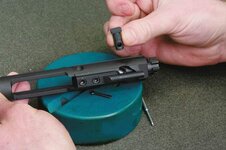Bronze Supporter
- Messages
- 9,379
- Reactions
- 17,956
The bolt is not the piston, it only acts as one.By having the bolt carrier act as a movable cylinder and the bolt act as a stationary piston, the need for a conventional gas cylinder, piston and actuating rod assembly is eliminated.
The only thing one could really say is that the AR is not DI or piston operated. Just easier to call it DI.














